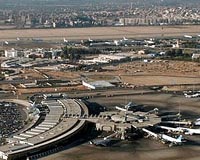| . |  |
. |
Paris (AFP) May 13, 2010 Scientists say they are now better prepared for measuring Iceland's volcanic ash problem, which is expected to continue for several months, after experiments using modelling and lasers to probe the atmosphere. By knowing how much ash is spewed from the volcano, scientists can map the way the cloud will spread depending on the wind, Pierre Flamant from a meteorological laboratory near Paris explained. During the air traffic chaos in mid-April, "there was an error in calculating ash emissions at the source", Gian Paolo Gobbi from Italy's institute of atmospheric sciences and climate said. "The Icelanders were not so well prepared when it came to measuring this," and the flaw subsequently skewed computer modelling of the plume, he said. But a German team carried out its own measurements of the output from Eyjafjoell volcano in early May, and this has given scientists a better fix. In an eruption event measuring three tonnes per second, many of the heaviest particles fell back down again within seven hours of being emitted. What is measured in the cloud corresponds to the fine particles able to travel to Europe, said Ulrich Schumann, director of the Institute of Atmospheric Physics at the the German Aerospace Centre (DLR). These facts should enable scientists to refine their models. "Only use of models, underpinned by land, aerial and satellite observations, can provide a correct representation of the situation," Schumann said. He told a conference in Vienna on May 5 that he believed scientists were now "much better prepared" than they were in April. Laser technology also plays a leading role, probing the atmosphere from the ground, planes or satellites. Lidar (Light Detection And Ranging) works similarly to radar, using very short laser pulses to determine the distance of air particles from the ground up to 15 kilometres (nine miles) in altitude. The European network Earlinet has 21 Lidar stations on the ground in Europe. "Lidar are particularly useful for getting details on the concentration of ash in the atmosphere," French researcher Emmanuel Rosencher said. Other technology complements the information provided by lasers, such as planes equipped with probes that can count the particles in the air and measure their size, allowing scientists to better judge their density. Eyjafjoell began erupting on April 14, triggering the biggest aerial shutdown in Europe since World War II. The cost to the aviation industry is put at more than a billion dollars. Jet aircraft are grounded because the very fine ash can become superheated to melting point when ingested by their engines. This can cause the engine to shut down or inflict such damage that an extensive and costly rebuild is necessary.
Share This Article With Planet Earth
Related Links Bringing Order To A World Of Disasters When the Earth Quakes A world of storm and tempest
 Airports hit by ash cloud disruption reopen
Airports hit by ash cloud disruption reopenMadrid (AFP) May 12, 2010 Restrictions on flights to and from airports in Spain, Portugal and Morocco were on Wednesday lifted following days of disruption caused by volcanic ash cloud. In Spain, all airports resumed normal operations, with Valencia, the last to see restrictions lifted, reopening from 0600 GMT, said the Spanish air traffic control organisation Aena. A ban on flights was also lifted at all Portugu ... read more |
|
| The content herein, unless otherwise known to be public domain, are Copyright 1995-2010 - SpaceDaily. AFP and UPI Wire Stories are copyright Agence France-Presse and United Press International. ESA Portal Reports are copyright European Space Agency. All NASA sourced material is public domain. Additional copyrights may apply in whole or part to other bona fide parties. Advertising does not imply endorsement,agreement or approval of any opinions, statements or information provided by SpaceDaily on any Web page published or hosted by SpaceDaily. Privacy Statement |